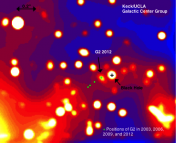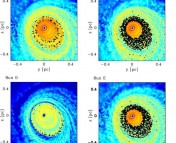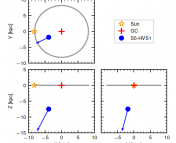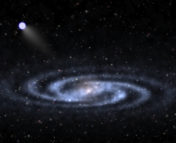Title: Probing orbits of stellar mass objects deep in galactic nuclei with quasi-periodic eruptions
Authors: Cong Zhou, Lei Huang, Kangrou Guo, Ya-Ping Li, Zhen Pan
First Author’s Institution: CAS Key Laboratory for Research in Galaxies and Cosmology, University of Science and Technology of China
Access: Accepted to Physical Review D [closed access]
The centers of galaxies are messy.
We’re pretty sure most galaxies have a supermassive black hole (SMBH) at their center — that’s an object more than 100,000 times the mass of the Sun compacted into an infinitely small point. A crazy start!
Around that, most galaxies have a dense cluster of stars and stellar mass black holes, with millions of objects often packed within a fraction of a percent of the galaxy’s total radius. Relative to how close-together stars are in the solar system’s neighborhood, that’s like if you took all the people living in the 48 contiguous United States and forced them to live in two copies of Central Park — that is, a million times more densely packed. These clumps are known as nuclear star clusters (after their home, the galactic “nucleus”).
With so many stars, living and dead, existing in such close quarters, we’re constantly discovering new processes within these nuclei. It was no more than five years ago, in fact, that astronomers first noticed the phenomenon that’s the focus of today’s paper. Enter: the quasi-periodic eruption.
—
One of the most exciting terms an astronomer can hear is “quasi–”. These two little syllables — signifying that a thing is almost something, but not quite — often mean that we don’t yet understand what’s going on; a problem to solve!
That was the case in 2019, when Giovanni Miniutti et al. published a paper on GSN 069 — a galaxy whose nucleus had, for at least 54 days, been sending out flares of X-rays on nearly periodic, 9-hour cycles. The team dubbed this unexplained phenomenon a “quasi-periodic eruption” (QPE), and astronomers had a new thing to figure out.
In the five years since, a few more examples of QPEs have popped up in other galaxies. Theorists have had a field day, putting forth a slew of models seeking to explain them. Today’s paper focuses on just one of them.
First, let’s think like a theorist would: the nearly periodic signal suggests an orbit — maybe a smaller body is orbiting the SMBH and causing the eruptions somehow? If the orbit is tight enough, the smaller body could certainly have a period as short as a few hours. Additionally, there’s enough chaos within the messy galactic center to cause some changes in the orbit timing — that is, to give us the “quasi-” in “quasi-periodic”. But what’s causing the flares themselves?
—
Today’s paper looks at one of the presently leading theories, which employs two processes that were each well-studied before the dawn of our observations of QPEs.
The first — a tidal disruption event (TDE) — happens when a star strays just a bit too close to a SMBH. In this case, the star’s own gravity can’t hold it together, and it gets stretched into a long strand of gas. (Check out this simulation of what this might look like!) That gas, we suspect, eventually forms into a disk of material around the black hole.
The second is even more of a mouthful: an extreme mass ratio inspiral (EMRI). In this event, something roughly the mass of the Sun orbits a SMBH (a ratio between masses of up to a billion) with relative stability; however, its orbital separation shrinks slightly over time due to gravitational wave emission. Eventually, the separation shrinks until the smaller body is orbiting just a bit beyond where a TDE might occur.
If you put these two together — or, more specifically, if you imagine an EMRI happening a few years after a TDE, around the same SMBH — you get an EMRI+TDE. (Not to be confused with an ABC-DEFG… okay, I made that one up, but astronomers sure do love their acronyms.)
In this model, the small mass of the EMRI collides with the TDE-remnant disk twice every orbit. These collisions punch out a cloud of gas (the orange blob in Figure 1), which gains a significant amount of heat during the impact. This cloud would glow like a typical blackbody — the standard, spherical-cow-style model for how things with temperature emit light — and its emission would evolve over time as the cloud cools.
Interestingly, this model can explain some of the quasi-periodicity of observed QPEs (take a look at Figure 2 for an example observation). Since orbits aren’t perfectly circular, the time between two given flares may be slightly longer than average, then slightly shorter, then longer again, and on and on — this long-short-long timing seems to be a feature of the QPEs we’ve seen so far. Also, depending on how the TDE-remnant-disk is oriented relative to us, we might get a cycle of flares that are brighter, then dimmer, then brighter, then dimmer, and on and on — another observed feature!
Presumably, this gas-cloud-punching and subsequent emission could happen again and again (twice per orbit!) until the star is eventually destroyed by the repeated collisions. The flares in this model agree with the sort-of-cyclic signals (or… quasi-periodic eruptions) we’ve been seeing.
Today’s paper seeks to refine and test this model in the context of that first QPE, GSN 069.
After detailing a rigorous model of the phenomenon described above, the authors use Bayesian inference to try to figure out what the physical properties of the GSN 069 QPE must be — things like the mass of the small EMRI body, the period of its orbit, and the density of the TDE-remnant gas disk — based on observed data.
They consider the shape of each flare — which is only related to the emission process, and thereby to the structure of the TDE-remnant-disk — separately from the timing between flares — which is only related to the orbital behavior of the EMRI. It’s a stroke of luck that the processes are so conveniently separable: by only considering one process at a time, they’re able to get smaller uncertainties on all the parameters they’re trying to determine.
In short, the authors find that an EMRI+TDE model seems to capture a lot of the features of the GSN 069 light curve. The model seems to be a good fit! In the summary section, they give a much more thorough rundown of the current state of QPE modeling than that given here.
Finally, the authors arrive at the point made by the title of the article. Imagine we’re (somehow) able to confirm that QPEs do come from this EMRI+TDE scheme. Fitting the parameters of these systems would then tell us about the objects involved in both EMRIs and TDEs. The period of the orbits, and how frequently we see QPEs, would tell us about how often stellar-mass objects end up on really tight orbits around SMBHs, for example. Constraints on disk properties could tell us not just what sort of stars undergo TDEs, but also how the leftover gas evolves after such an event.
In short, if QPEs are EMRIs after a TDE, fitting the observed bursts would give us beautiful insights into what sorts of bodies end up super close to supermassive black holes — providing invaluable milestones on the road to understanding the messy dynamics of galactic centers.
Both through continuing X-ray observations — and by looking back at archival data to find ones we’ve missed — the census of QPEs is expected to grow over the coming years. As it does, perhaps such constraints will become possible. Until then, there’s always more work to be done on the theoretical side to make sure our models make sense.
Astrobite edited by Keighley Rockcliffe.
Featured image credit: MPE; optical image: DESI Legacy Imaging Surveys/D. Lang (Perimeter Institute)




